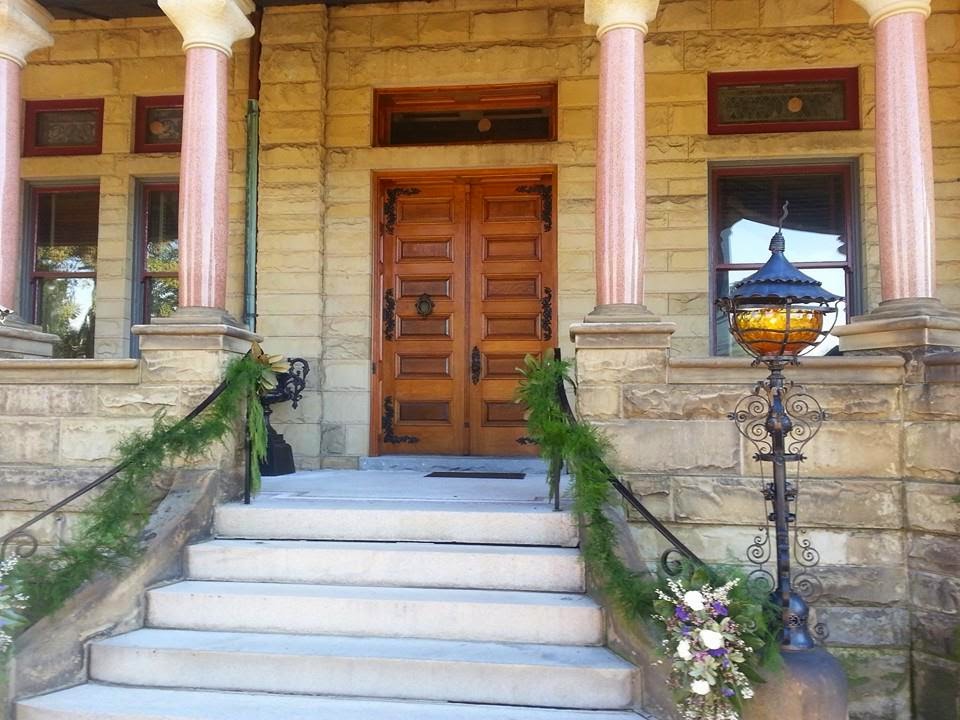Maymont viewed from the modern walkway leading up to the mansion. While in 1893, visitors would have disembarked from carriages under the covered entrance, today visitors first enter the house through the basement service entrance where tickets are purchased. Photograph taken by Michelle L. Hamilton.
With tickets in hand, Mom and I left the basement and followed the walkway under the covered entrance to Maymont's formal entrance. Photograph taken by Michelle L. Hamilton.
Our lovely tour guide Evelyn welcomed us into Maymont. In the foyer the portrait of James and Sallie Dooley grace the walls of their home. The Dooleys first viewed the land that would become their home while the couple were out riding. Sallie Dooley became enchanted with the view and asked her husband to buy the land and to build her a home there. James Dooley purchased the land in 1889, the next year construction began on the mansion and Maymont was completed in 1893. James Dooley named the mansion Maymont in honor of his wife Sallie May. Photograph taken by Michelle L. Hamilton.
James Dooley's library. Born in Richmond on January 17, 1841 to Irish immigrants, James Dooley fought in the Civil War for the Confederacy. After the war James Dooley became a lawyer, but would make his fortune as an industrialist. Serving on several boards Dooley helped rebuild the war torn South. James Dooley was a man of his times and was conservative in his politics and was aghast at the idea that women should be granted the right to vote--a sentiment that would divide his family. Photograph taken by Michelle L. Hamilton.
Sallie Dooley's formal parlor. Born in Lunenburg County, Virginia on July 23, 1846, Sallie May was the eighth of nine children born to an old and established Virginia family. When she was seven years old her mother died, Sallie was then raised by her older, married sisters. In 1869, Sallie May married James Dooley, at the time the marriage was scandalous as the bride had been raised an Episcopalian and the groom was Roman Catholic. Writing to a family member after the ceremony, Sallie asked that the it be kept a secret that she had been married by a Catholic priest. Photograph taken by Michelle L. Hamilton.
The formal dining room. The Dooley's were know for their fine entertainments and this room saw many elegant dinners. Photograph taken by Michelle L. Hamilton.
Sallie Dooley's card room on the second floor. Maymont was at the center of Richmond high society and many parties and gatherings took place here. Sallie Dooley was for her fine Southern hospitality. Fond of playing cards, Sallie Dooley would invite her lady friends to an afternoon of cards in her card room where they would play the fashionable and popular game of Bridge.Photograph taken by Michelle L. Hamilton.
The staircase lead up to the third floor where the guest rooms and some servant quarters where located. Even though the Dooleys where childless, the couple did come from large families and their nieces and nephews where frequent guests at Maymont. During this tour we did not visit the third floor. Photograph taken by Michelle L. Hamilton.
Sallie Dooley's dressing room. The room also featured a bed that Sallie could relax on before her next event. In James Dooley's dressing room there is also a bed. The rooms proved difficult to photograph as I was not allowed to use my camera's flash. Photograph taken by Michelle L. Hamilton.
James and Sallie Dooley's bathroom. When Maymont was constructed it included ever modern convenience, gas and electricity and an elevator that connected the basement kitchen to the butler's pantry on the first floor. Photograph taken by Michelle L. Hamilton.
Reproduction of the servants uniforms. While on duty female servants had to wear their uniform, they even had to wear their uniform even when they left Maymont if they were in the company of Sallie Dooley--a practice that the ladies found degrading. Photograph taken by Michelle L. Hamilton.
James Dooley's wine cellar. Even during Prohibition, which came early to Virginia in 1916, James Dooley kept his wine cellar stocked at Maymont and Swannanoa. Photograph taken by Michelle L. Hamilton.
Maymont is a fascinating location and I highly recommend visiting. I will be returning, as the estate features different tours and events throughout the year. For more information please visit: http://maymont.org/.

























































